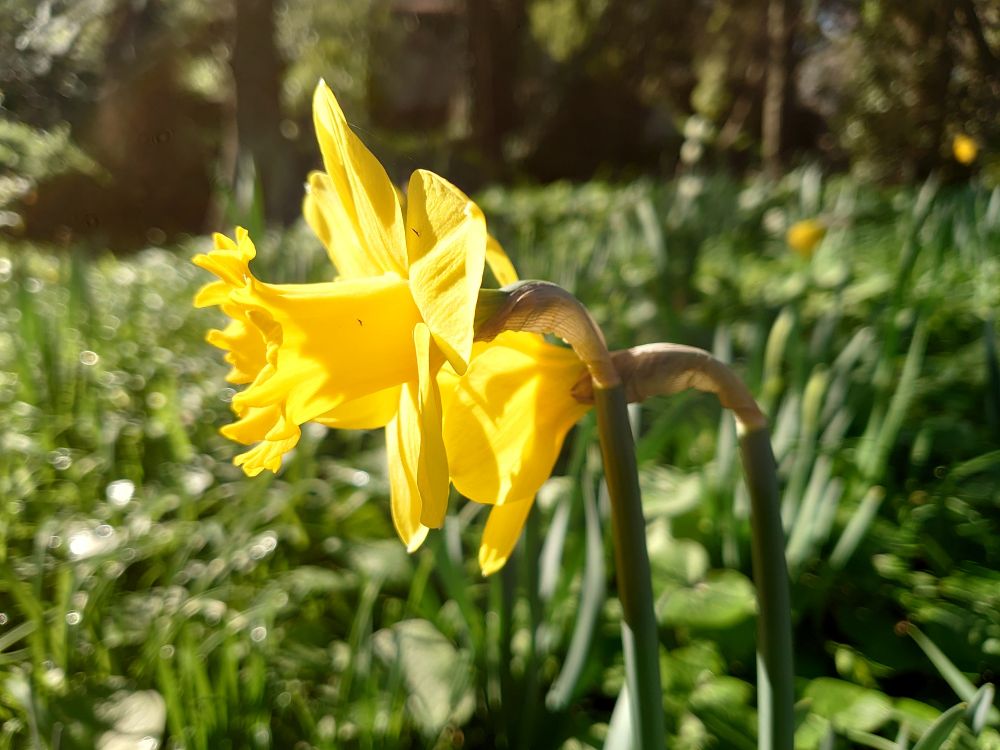
Michele Bannister
@astrokiwi.bsky.social
Planetary astronomer @UCNZ: envisioning worlds from here and elsewhere, in a dark & glorious sky. Rutherford Discovery Fellow. Asteroid (10463). Pākehā; she
First of the cornflowers, last of the freesias. Orlaya is a drifting sea of umbels. #bloomscrolling
First flower vase I've had a chance to pick in quite a while 🌱🇳🇿
First flower vase I've had a chance to pick in quite a while 🌱🇳🇿

November 6, 2025 at 8:34 AM
First of the cornflowers, last of the freesias. Orlaya is a drifting sea of umbels. #bloomscrolling
First flower vase I've had a chance to pick in quite a while 🌱🇳🇿
First flower vase I've had a chance to pick in quite a while 🌱🇳🇿
Season of the rhodo continues

November 5, 2025 at 4:44 AM
Season of the rhodo continues
Already exceeded that at Mt John Observatory: max gust today so far 178 km/h

October 22, 2025 at 11:32 PM
Already exceeded that at Mt John Observatory: max gust today so far 178 km/h
Small fuzzball time 🌸

September 25, 2025 at 10:47 AM
Small fuzzball time 🌸
Or also, from same timeframe arxiv.org/abs/2507.02757

August 21, 2025 at 2:53 AM
Or also, from same timeframe arxiv.org/abs/2507.02757
Volatile time! As anticipated for a comet ☄️, interstellar object 3I/ATLAS is now showing water - thanks to OH emission seen by Swift in the UV. A little distant at 3.51 au, but that suggests it could be from water ice grains in the coma.
Xing et al., ApJL submitted 🔭 arxiv.org/abs/2508.04675
Xing et al., ApJL submitted 🔭 arxiv.org/abs/2508.04675

August 7, 2025 at 2:55 AM
Volatile time! As anticipated for a comet ☄️, interstellar object 3I/ATLAS is now showing water - thanks to OH emission seen by Swift in the UV. A little distant at 3.51 au, but that suggests it could be from water ice grains in the coma.
Xing et al., ApJL submitted 🔭 arxiv.org/abs/2508.04675
Xing et al., ApJL submitted 🔭 arxiv.org/abs/2508.04675
3I/ATLAS measurement from HST is in: can see the coma but not the nucleus. Sets effective nuclear radius of r < 2.8 km (H>15.4), significantly smaller than earlier estimates (as anticipated).
Jewitt et al, (submitted?) arxiv.org/abs/2508.02934 🔭☄️
Jewitt et al, (submitted?) arxiv.org/abs/2508.02934 🔭☄️

August 6, 2025 at 3:17 AM
3I/ATLAS measurement from HST is in: can see the coma but not the nucleus. Sets effective nuclear radius of r < 2.8 km (H>15.4), significantly smaller than earlier estimates (as anticipated).
Jewitt et al, (submitted?) arxiv.org/abs/2508.02934 🔭☄️
Jewitt et al, (submitted?) arxiv.org/abs/2508.02934 🔭☄️
First daffodils in the park #bloomscrolling

August 2, 2025 at 4:43 AM
First daffodils in the park #bloomscrolling
Formosa cherry (Jury sterile cultivar) brings the first bud-burst blossom of winter

August 1, 2025 at 6:56 AM
Formosa cherry (Jury sterile cultivar) brings the first bud-burst blossom of winter
If you like thinking about this at a bit more of a technical level, have a look at the shape of the light from the stars (which is what the telescope tracks on) and the shape of the light from the comet (which is moving a little, and you can account for that). There's a discussion on p. 20

July 21, 2025 at 6:05 AM
If you like thinking about this at a bit more of a technical level, have a look at the shape of the light from the stars (which is what the telescope tracks on) and the shape of the light from the comet (which is moving a little, and you can account for that). There's a discussion on p. 20
So, what do these observations from @vrubinobs.bsky.social show us about 3I/ATLAS? Well, from as early as June 21, ten days prior to discovery and the earliest that any large-aperture telescope has imagery — it's a comet. The July 3 stack shows it really clearly

July 21, 2025 at 5:54 AM
So, what do these observations from @vrubinobs.bsky.social show us about 3I/ATLAS? Well, from as early as June 21, ten days prior to discovery and the earliest that any large-aperture telescope has imagery — it's a comet. The July 3 stack shows it really clearly
Together with some other engineering-test-focussed observations, this meant Rubin has imaged 3I/ATLAS about 37 times so far. The comet is in a dense stellar field, so as you can see in this example gallery, every so often 3I crossed over background stars

July 21, 2025 at 5:48 AM
Together with some other engineering-test-focussed observations, this meant Rubin has imaged 3I/ATLAS about 37 times so far. The comet is in a dense stellar field, so as you can see in this example gallery, every so often 3I crossed over background stars
During this time one of the sequences of observations is known as the Science Verification Survey. It's across an area of sky that lets the data reduction pipelines practise how well they work, and includes observations in the dense starfields of the Galaxy.
And it imaged 3I/ATLAS!
And it imaged 3I/ATLAS!

July 21, 2025 at 5:40 AM
During this time one of the sequences of observations is known as the Science Verification Survey. It's across an area of sky that lets the data reduction pipelines practise how well they work, and includes observations in the dense starfields of the Galaxy.
And it imaged 3I/ATLAS!
And it imaged 3I/ATLAS!
Coming into crocus time #bloomscrolling 🌱🇳🇿

July 20, 2025 at 5:42 AM
Coming into crocus time #bloomscrolling 🌱🇳🇿
The orbit of 2023 KQ14 is also opposite in orientation (longitude of perihelion) to other Sedna-like orbits.

July 15, 2025 at 10:11 AM
The orbit of 2023 KQ14 is also opposite in orientation (longitude of perihelion) to other Sedna-like orbits.
This new-found trans-Neptunian object, 2023 KQ14, has the third-highest known perihelion at q=66 au (a=252 au and inclination i=11°). Excitingly, that means it fills the 'perihelion gap' we talked about in our 2020 book chapter (Kavelaars et al)

July 15, 2025 at 10:01 AM
This new-found trans-Neptunian object, 2023 KQ14, has the third-highest known perihelion at q=66 au (a=252 au and inclination i=11°). Excitingly, that means it fills the 'perihelion gap' we talked about in our 2020 book chapter (Kavelaars et al)
That thick-disk origin means 3I/ATLAS is infalling from a more southerly direction than most of the interstellar objects that the Ōtautahi–Oxford model suggests, which come in from the North. This makes its orbit one that would be pretty unusual for @vrubinobs.bsky.social to see, for instance!

July 9, 2025 at 4:40 AM
That thick-disk origin means 3I/ATLAS is infalling from a more southerly direction than most of the interstellar objects that the Ōtautahi–Oxford model suggests, which come in from the North. This makes its orbit one that would be pretty unusual for @vrubinobs.bsky.social to see, for instance!
3I/ATLAS also seems like it could be somewhat older than 1I and 2I were. It's pretty incredible to think of this new-seen tiny world as wandering our Galaxy for upwards of 8 billion years.

July 9, 2025 at 4:25 AM
3I/ATLAS also seems like it could be somewhat older than 1I and 2I were. It's pretty incredible to think of this new-seen tiny world as wandering our Galaxy for upwards of 8 billion years.
We can also predict that 3I/ATLAS came from a metallicity of star that was more metal-poor; ISOs from these stars tend to be more water-rich. So, a prediction for observers!
As we found yesterday, no gas emission yet in VLT/MUSE spectra, but maybe we'll see some as 3I gets more heated by the Sun?
As we found yesterday, no gas emission yet in VLT/MUSE spectra, but maybe we'll see some as 3I gets more heated by the Sun?

July 9, 2025 at 4:20 AM
We can also predict that 3I/ATLAS came from a metallicity of star that was more metal-poor; ISOs from these stars tend to be more water-rich. So, a prediction for observers!
As we found yesterday, no gas emission yet in VLT/MUSE spectra, but maybe we'll see some as 3I gets more heated by the Sun?
As we found yesterday, no gas emission yet in VLT/MUSE spectra, but maybe we'll see some as 3I gets more heated by the Sun?
What does the Ōtautahi–Oxford model tell us? 3I/ATLAS is coming in fast, but well within what's expected. Its large vertical velocity suggests it's here from a part of the Galaxy known as the thick disk - different from the part the Sun lives within


July 9, 2025 at 4:15 AM
What does the Ōtautahi–Oxford model tell us? 3I/ATLAS is coming in fast, but well within what's expected. Its large vertical velocity suggests it's here from a part of the Galaxy known as the thick disk - different from the part the Sun lives within
Finally, the cosy little dusty veil that 3I/ATLAS has is moderately red. We aren't seeing the surface of 3I directly, due to that coma. This is also like 2I/Borisov. For 1I/ʻOumuamua, it had no detectable coma, and observations were measuring light reflecting from its surface.

July 8, 2025 at 12:16 PM
Finally, the cosy little dusty veil that 3I/ATLAS has is moderately red. We aren't seeing the surface of 3I directly, due to that coma. This is also like 2I/Borisov. For 1I/ʻOumuamua, it had no detectable coma, and observations were measuring light reflecting from its surface.
What we show in this one visit by VLT/MUSE is that the coma of 3I is just dusty: there's no gas emission yet. MUSE's range covers the molecules of C2, red CN, and NH2, plus Cyrielle checked for [OI]; look at that pretty continuum, all quiet here

July 8, 2025 at 12:02 PM
What we show in this one visit by VLT/MUSE is that the coma of 3I is just dusty: there's no gas emission yet. MUSE's range covers the molecules of C2, red CN, and NH2, plus Cyrielle checked for [OI]; look at that pretty continuum, all quiet here
Subthread 🧵:what does VLT/MUSE show us about interstellar object 3I/ATLAS? Plenty!
First: 3I has a coma, so it is also a comet. Here's the 'white light' (summed whole-MUSE-wavelength range) deep stack image of our observations on July 3 🔭
First: 3I has a coma, so it is also a comet. Here's the 'white light' (summed whole-MUSE-wavelength range) deep stack image of our observations on July 3 🔭

July 8, 2025 at 11:48 AM
Subthread 🧵:what does VLT/MUSE show us about interstellar object 3I/ATLAS? Plenty!
First: 3I has a coma, so it is also a comet. Here's the 'white light' (summed whole-MUSE-wavelength range) deep stack image of our observations on July 3 🔭
First: 3I has a coma, so it is also a comet. Here's the 'white light' (summed whole-MUSE-wavelength range) deep stack image of our observations on July 3 🔭
And that's...quite a bit of NH2, surely? Well, compared to Solar System comets, we haven't seen too many as rich in NH2 as 2I/Borisov, but there are ones that are richer.
2I certainly counts as volatile-rich. It has to have formed in the outer reaches of its home system, and not been baked since
2I certainly counts as volatile-rich. It has to have formed in the outer reaches of its home system, and not been baked since

July 8, 2025 at 11:13 AM
And that's...quite a bit of NH2, surely? Well, compared to Solar System comets, we haven't seen too many as rich in NH2 as 2I/Borisov, but there are ones that are richer.
2I certainly counts as volatile-rich. It has to have formed in the outer reaches of its home system, and not been baked since
2I certainly counts as volatile-rich. It has to have formed in the outer reaches of its home system, and not been baked since
The gas maps are pretty smooth, for the three molecules we're looking at: C2, NH2 and CN. Let's look at how gas is produced by the interstellar comet as it comes in past the Sun: it really picks up when 2I fragments after perihelion!


July 8, 2025 at 11:05 AM
The gas maps are pretty smooth, for the three molecules we're looking at: C2, NH2 and CN. Let's look at how gas is produced by the interstellar comet as it comes in past the Sun: it really picks up when 2I fragments after perihelion!

